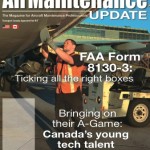Sending out Strong Signals
In the second installment of a two-part series, Gord Walker explains why some avionics systems are “vintage” in name only.
Driving westbound out of Toronto toward my new home in Port Burwell, I was treated to the spectacle of several wide-body aircraft on final approach to Pearson Airport. After 35 years in the aviation business and nearly 20 years of “Plane Spotting” before that, I’m delighted to say that I still marvel at, and am thrilled by such a sight. The majesty and grace with which those big metal birds seem to float toward the ground, coupled with the engineering marvel that is up to one million pounds of aircraft actually flying, is a vision I find truly moving. Something that saddens me, however, is the lack of panache, style, and distinction when it comes to the appearance of modern airliners.
Just as automobiles of the 1950s, ‘60s, and ‘70s offered streamlined body styles, chrome accessories, tailfins, spoilers, hood scoops, and fender flares, commercial aircraft of that time also offered distinctive styling and engine options. One could quickly and easily identify aircraft as being a 727, 737, DC-9, DC-10, or 747 due to their unique appearance. There were some challenges for non-experts of course, who may have had trouble distinguishing an L10-11 from a DC-10; a 707 from a DC-8; or the more obscure VC 10 from an IL 62, but there were styling differences that the trained eye could spot, even at 25,000 feet. However, in the modern era, whether I look skyward, or across the tarmac at a crowded international airport, I see nothing but a sea of large, wing-mounted twin-engine wide-bodies. They all look the same—subtle differences in winglet style or angle of wing sweep notwithstanding.
No question the present generation of “Heavy Metal” airliners is far more efficient, economical, and environmentally friendly (well, everything is relative) than those old beasts from the past, but they just don’t have the same character and style.
The same holds true for avionics systems I believe. Sure, GPS driven, moving map digital colour video displays are nice to look at, easy to interpret, and simple to operate, but they don’t carry the same intrigue and challenge as those old post-WWII navigation systems we’ve been using for the last 70 years or thereabouts. So, as we give a tip of the hat to the aeronautical design engineers of those beautiful vintage passenger jets, let us resume our look at some of the aging, but still available and operational “vintage” avionics systems.
 In our April-May 2014 issue (Read “They’re not Antiquated; They’re Vintage.”), we examined the instrument landing system (ILS) with its Localizer providing lateral guidance and Glideslope providing vertical guidance to the runway in conditions of poor visibility. We also looked at Distance Measuring Equipment, (DME) which indicates the distance between the aircraft and the ILS runway. The DME can be used with another vintage avionics system known as the Very High Frequency Omni Range navigation system, or VOR.
In our April-May 2014 issue (Read “They’re not Antiquated; They’re Vintage.”), we examined the instrument landing system (ILS) with its Localizer providing lateral guidance and Glideslope providing vertical guidance to the runway in conditions of poor visibility. We also looked at Distance Measuring Equipment, (DME) which indicates the distance between the aircraft and the ILS runway. The DME can be used with another vintage avionics system known as the Very High Frequency Omni Range navigation system, or VOR.
The VOR provides enroute navigation information by indicating to the pilot the aircraft’s position, relative to the VOR transmitter antenna on the ground. If the aircraft is equipped with a Radio Magnetic Indicator (RMI) the VOR needle will point toward the VOR station selected by the pilot. This indication appears similar to the indication seen when a non-directional beacon (NDB) is tuned using the automatic direction finder, (ADF) but there is in fact a significant difference between the VOR indication, and the ADF indication.
 The VOR system works in conjunction with the gyro-driven compass card in the RMI, whereas the ADF does not. This means that the ADF needle will simply point toward the NDB that the pilot tuned his ADF receiver to. If you were to manually rotate the compass card, the ADF needle would continue to point toward the NDB. The VOR needle on the other hand points toward the RMI’s compass card heading that would take the aircraft TO the VOR transmitter selected by the pilot. If we were to manually rotate the compass card in the RMI, the VOR needle would rotate WITH the card, continually pointing toward the compass heading that would take the aircraft to the VOR transmitter. This type of VOR indication, using an RMI is known as “automatic” VOR indication. Manual VOR indication involves the use of a Course Deviation Indicator (CDI) and is a little trickier to interpret.
The VOR system works in conjunction with the gyro-driven compass card in the RMI, whereas the ADF does not. This means that the ADF needle will simply point toward the NDB that the pilot tuned his ADF receiver to. If you were to manually rotate the compass card, the ADF needle would continue to point toward the NDB. The VOR needle on the other hand points toward the RMI’s compass card heading that would take the aircraft TO the VOR transmitter selected by the pilot. If we were to manually rotate the compass card in the RMI, the VOR needle would rotate WITH the card, continually pointing toward the compass heading that would take the aircraft to the VOR transmitter. This type of VOR indication, using an RMI is known as “automatic” VOR indication. Manual VOR indication involves the use of a Course Deviation Indicator (CDI) and is a little trickier to interpret.
The VOR system operates by comparing the phase angle of two 30-Hz signals being transmitted by the VOR beacon on the ground. The 30-Hz “reference” signal is a frequency modulated (FM) signal and the 30-Hz “variable” frequency is an amplitude modulated signal. If the aircraft is directly north of the VOR station, the two 30-Hz signals (reference and variable) will be in phase with one another. When the VOR receiver on board the aircraft receives the two 30-Hz signals “in-phase”, it interprets this as the aircraft being north of the station, and will therefore drive the RMI needle such that it points to 180 degrees (the compass heading which would take the aircraft TO the VOR station). If the aircraft is directly east of the VOR station, the reference and variable signals will be 90 degrees out of phase; if the aircraft is south of the VOR, the signals will be 180 degrees out of phase; and so on.
In terms of manual VOR indication, the pilot can use the “course select” feature of the horizontal situation indicator (HSI) to select a course of either 180 degrees, or 000 degrees, causing the needle in the CDI to move to the centred “On Course” position. There is a “TO/FROM” indicator associated with the CDI, and it indicates what the aircraft would do, IF the pilot were to actually fly the selected course. In the case of the aircraft being directly north of the VOR transmitter, selecting a course of 180 would take the aircraft TO the station, and 000 degrees would take the aircraft away FROM the station.
The term “radial” is used to describe the 360 degrees around the VOR transmitter, and can be thought of as being like spokes on a wheel. In our earlier example, we were north of the station, so we were on the 000/180 degree radial (000-From/180 TO). If your aircraft was on the 045 degree radial with a “TO” indication, that would indicate that you are south-west of the VOR station, as flying a heading of 45 degrees would take you TO it.
The VOR system operates in the VHF frequency range of 108-117.95 MHz. (non-localizer frequencies). When a VOR frequency is selected, the DME is automatically tuned to a paired frequency, thus giving the pilot direction to, and distance from the VOR transmitter. This enables accurate pinpointing of the aircraft’s current position. Should the aircraft not be equipped with a DME system, a position fix can be established by tuning to multiple VOR stations, noting which radials the aircraft is located on, and determining their intersection point.
The VOR system uses a horizontally polarized antenna, and these are often located on the vertical stabilizer or combined with the VHF communications antenna (the “boomerang” shaped section of the antenna is the VOR/LOC antenna). Although a little bit challenging to use, the VOR system has provided us with very effective overland point-to-point navigation capabilities for many years. Whether it becomes a casualty of modernization or not only time will tell, but it remains in service for the time being.
And of those distinctive old (or vintage) airliners, do you have a particular favourite? My personal choice has always been the Lockheed Super Constellation. That graceful arched fuselage and majestic tripletail makes it, at least in my opinion, the most fetching of all passenger airplanes ever built, the likes of which we’re not likely to ever see again. Pity.
Question based on this article; the answer in next issue:
Q: If an aircraft is directly west of a VOR station and the pilot selects a course of 90 degrees, the deviation bar in the CDI will move to the centred, “on-course” position. What will the “TO/FROM” indication be?
Answers to questions from the previous issue:
Q1: What is the purpose of the “Localizer” system?
A1: The Localizer provides lateral guidance to the runway’s centreline.
Q2: What is the airborne DME radio called?
A2: The airborne DME transceiver is called an “interrogator”.
About The Author
GORDON WALKER entered the avionics industry after graduation from Centennial College in 1980. His career with Nordair, Air Canada, CP Air, PWA, and ultimately Canadian Airlines took him to many remote corners of Canada. Since leaving the flight line to pursue a career as a college professor, Walker has continued to involve himself in the aviation/avionics industry, by serving on several CARAC Committees concerning the training and licensing of AMEs, being nominated to the CAMC Board of Directors, and being elected President of the National Training Association. (NTA).
View all articles by Gordon Walker.















































